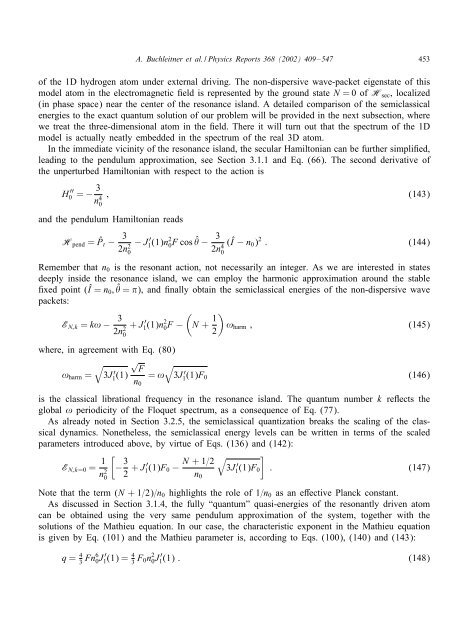Non-dispersive wave packets in periodically driven quantum systems
Non-dispersive wave packets in periodically driven quantum systems
Non-dispersive wave packets in periodically driven quantum systems
You also want an ePaper? Increase the reach of your titles
YUMPU automatically turns print PDFs into web optimized ePapers that Google loves.
A. Buchleitner et al. / Physics Reports 368 (2002) 409–547 453<br />
of the 1D hydrogen atom under external driv<strong>in</strong>g. The non-<strong>dispersive</strong> <strong>wave</strong>-packet eigenstate of this<br />
model atom <strong>in</strong> the electromagnetic eld is represented by the ground state N =0 of Hsec, localized<br />
(<strong>in</strong> phase space) near the center of the resonance island. A detailed comparison of the semiclassical<br />
energies to the exact <strong>quantum</strong> solution of our problem will be provided <strong>in</strong> the next subsection, where<br />
we treat the three-dimensional atom <strong>in</strong> the eld. There it will turn out that the spectrum of the 1D<br />
model is actually neatly embedded <strong>in</strong> the spectrum of the real 3D atom.<br />
In the immediate vic<strong>in</strong>ity of the resonance island, the secular Hamiltonian can be further simpli ed,<br />
lead<strong>in</strong>g to the pendulum approximation, see Section 3.1.1 and Eq. (66). The second derivative of<br />
the unperturbed Hamiltonian with respect to the action is<br />
H ′′<br />
0 = − 3<br />
n 4 0<br />
; (143)<br />
and the pendulum Hamiltonian reads<br />
Hpend = ˆPt − 3<br />
2n2 − J<br />
0<br />
′ 1(1)n 2 0F cos ˆ − 3<br />
2n4 (Î − n0)<br />
0<br />
2 : (144)<br />
Remember that n0 is the resonant action, not necessarily an <strong>in</strong>teger. As we are <strong>in</strong>terested <strong>in</strong> states<br />
deeply <strong>in</strong>side the resonance island, we can employ the harmonic approximation around the stable<br />
xed po<strong>in</strong>t (Î = n0; ˆ = ), and nally obta<strong>in</strong> the semiclassical energies of the non-<strong>dispersive</strong> <strong>wave</strong><br />
<strong>packets</strong>:<br />
EN;k = k! − 3<br />
2n2 + J<br />
0<br />
′ 1(1)n 2 0F −<br />
where, <strong>in</strong> agreement with Eq. (80)<br />
√<br />
F<br />
<br />
!harm = 3J ′ 1 (1)<br />
n0<br />
<br />
= ! 3J ′ 1 (1)F0<br />
<br />
N + 1<br />
<br />
!harm ; (145)<br />
2<br />
(146)<br />
is the classical librational frequency <strong>in</strong> the resonance island. The <strong>quantum</strong> number k re ects the<br />
global ! periodicity of the Floquet spectrum, as a consequence of Eq. (77).<br />
As already noted <strong>in</strong> Section 3.2.5, the semiclassical quantization breaks the scal<strong>in</strong>g of the classical<br />
dynamics. <strong>Non</strong>etheless, the semiclassical energy levels can be written <strong>in</strong> terms of the scaled<br />
parameters <strong>in</strong>troduced above, by virtue of Eqs. (136) and (142):<br />
EN;k=0 = 1<br />
n2 <br />
−<br />
0<br />
3<br />
2 + J ′ <br />
N +1=2<br />
1(1)F0 − 3J<br />
n0<br />
′ 1 (1)F0<br />
<br />
: (147)<br />
Note that the term (N +1=2)=n0 highlights the role of 1=n0 as an e ective Planck constant.<br />
As discussed <strong>in</strong> Section 3.1.4, the fully “<strong>quantum</strong>” quasi-energies of the resonantly <strong>driven</strong> atom<br />
can be obta<strong>in</strong>ed us<strong>in</strong>g the very same pendulum approximation of the system, together with the<br />
solutions of the Mathieu equation. In our case, the characteristic exponent <strong>in</strong> the Mathieu equation<br />
is given by Eq. (101) and the Mathieu parameter is, accord<strong>in</strong>g to Eqs. (100), (140) and (143):<br />
q = 4<br />
3 Fn6 0J ′ 1(1) = 4<br />
3 F0n 2 0J ′ 1(1) : (148)











